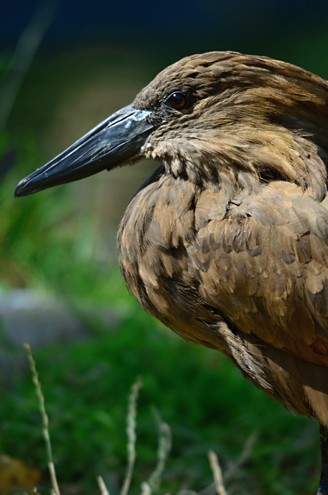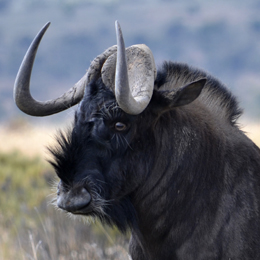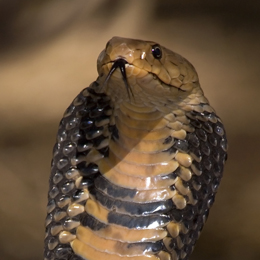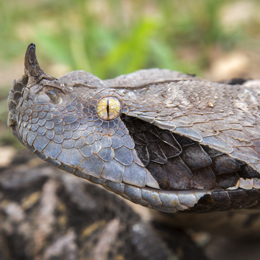Hamerkop
The hamerkop is a unique species of wading bird found primarily in Africa. As the name suggests, the head of the bird combined with the back crest and curved bill superficially makes up the shape of a hammer. The bird has several other names that include Anvilhead, Hammerkop, Hammerkopf, Hammerhead Stork, Hammerhead, Umber bird, Tufted Umber and Umbrette.
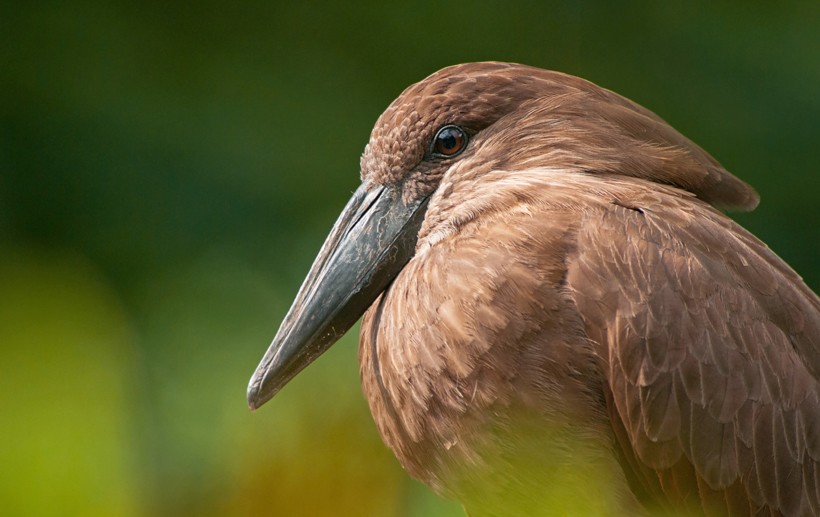
Portrait of adult hamerkop bird, germany
?
Image credits: Natalia Paklina/Shutterstock
The hamerkop is a medium-sized bird with an average body length of 56 cm (22 inches) and a mean weight of 470 g (17 ounces). The length of the wingspan ranges from 90 to 94 cm (3 ft). Its neck and legs are relatively short with the feet being partially webbed, helping in walking through shallow water while foraging. These birds have exceptional navigation skills and are able to build unusually huge nests. In fact, the nests of Hamerkops are so huge that they can easily accommodate a human being to sit in.
They occur in large numbers across their home range Africa and are not threatened globally. The average lifespan of this bird is almost 20 years which is quite long compared to the lifespan of other wading birds.
Subspecies
Although Hamerkops are usually considered as a species of the order Ciconiiformes (Herons, Storks, Egrets, Spoonbills and Ibises), they have been suspected to have a much closer relationship with the birds of the order Pelecaniformes. As a result, a majority of taxonomists classifies this bird as a species of Pelecaniformes. However, due to its several unique characteristics, this bird constitutes its own family called Scopidae and a separate genus named Scopus.
The species of Scopus umbretta has two subspecies:
- S. u. umbretta
This subspecies of Hamerkop is mainly found in the wetlands of tropical Africa, Madagascar and South-western Arabia.
- S. u. minor
Compared to S. u. umbretta, this subspecies is slightly smaller and exhibits a darker plumage. It inhabits the coastal belt ranging from Sierra Leone to eastern Nigeria.
This subspecies of Hamerkop is mainly found in the wetlands of tropical Africa, Madagascar and South-western Arabia.
Compared to S. u. umbretta, this subspecies is slightly smaller and exhibits a darker plumage. It inhabits the coastal belt ranging from Sierra Leone to eastern Nigeria.
Anatomy and Characteristics
The plumage of Hamerkop is uniformly brown with a slight purple sheen on the back. It has a long and flat bill that is almost straight except for the slight curve on the edge. The color of the bill and legs are alike which ranges from dark brown to black. Unlike other wading birds like Storks, Herons or Egrets, the legs of Hamerkop are relatively shorter. It also has a shorter neck which is rare among aquatic birds.
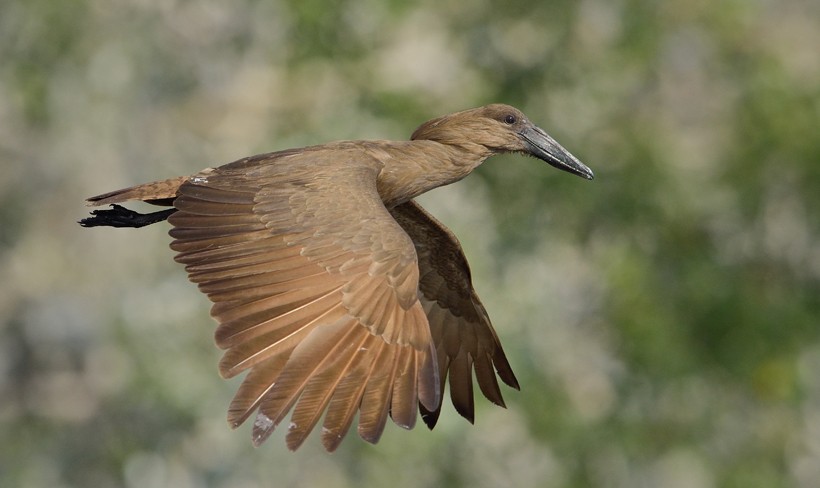
Hamerkop or Anvilhead flying in Southern Africa
?
Image credits: Neal Cooper/Shutterstock
Moreover, for some unknown reasons, the feet of the Hamerkop are partially webbed with the middle toe exhibiting a comb-like appearance which can also be seen in the feet of Herons. It has a short tail and large, wide and round-tipped wings that provide this bird the ability to fly at a higher altitude. When soaring, the Hamerkop extends its neck outward like a Stork and coils its neck inward like a Heron during flight. These birds remain mostly silent when found alone but display noisy behavior when found in groups. They usually cackle and give out a shrill cry during flight.
Habitat
Hamerkops are widespread all across sub-Saharan Africa and parts of Madagascar. Additionally, one of the subspecies also occurs along the coastal regions of South-Western Arabia. Regarding their habitat, these birds live in all kinds of wetlands ranging from rivers, marshes and lakes to temporary seasonal ponds. In fact, within their geographical range, Hamerkops can be seen in most places with easy access to large water bodies. They are even found around the man-made waterways like dams, irrigation channels or irrigated lands like the rice paddies.
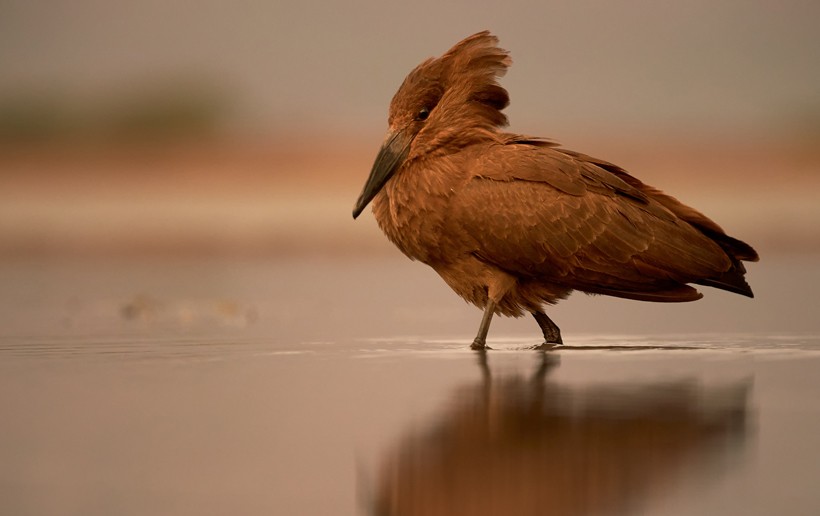
walking in shallow calm water during colorful sunset
?
Image credits: Martin Mecnarowski/Shutterstock
Depending on the season, Hamerkops may be seen also living around the semi-arid areas but they mostly prefer to stay in the woodlands and savannahs located around large bodies of water.
Although Hamerkops often limit their movement within their territories, some individuals might migrate to favorable habitats during rainy seasons when many new water bodies are formed. Moreover, these birds have been seen to move in quickly when a new form of water body like a canal or dam is made.
Diet, Hunting & Predation
Diet
Being a carnivorous bird, the diet of Hamerkop mostly includes amphibians. However, if available, this bird can also feed on fish, shrimp, small insects and rodents. The Hamerkops hunt and eat individually during the day while sparing a break around noon to roost. When in the companion of a mate, Hamerkops forage in pairs.
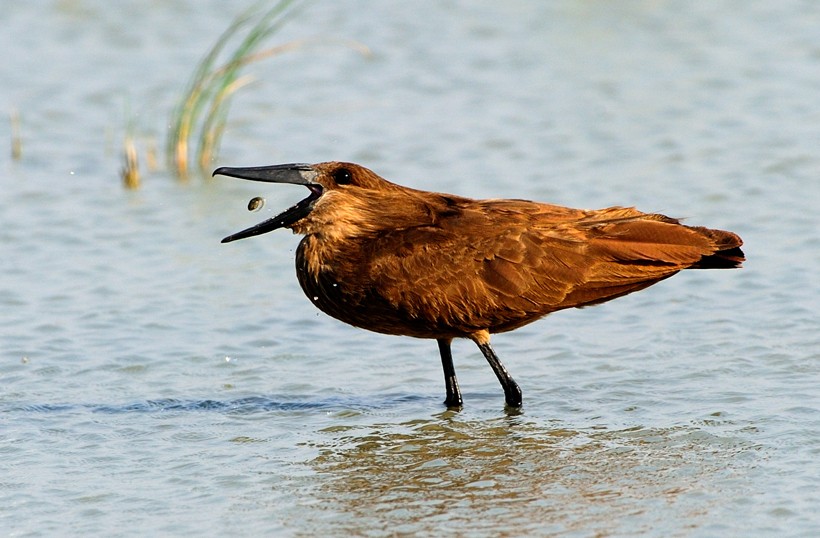
Hamerkop eating a tadpole
?
Image credits: Stephanie Periquet/Shutterstock
Hunting
Similar to Herons and Storks, Hamerkops look for their prey in shallow water. When foraging, they shuffle their feet slowly with one foot on the bottom at a time and stealthily catch the prey off guard. In order to flush out their prey from hiding, Hamerkops flap their wings suddenly in order to startle their prey. These birds are also able to feed during a flight over open water by gliding over and suddenly dipping down to grab a fish. They are excellent hunters but larger birds like Fish Eagles often rob them from their prey which compels the Hamerkops to catch a lot of prey for satisfying their appetite.
Predation
Adult Hamerkops seldom get predated due to their agility and excellent flying skills. However, their eggs and chicks remain at high risk for predation by Snakes or Monitor Lizards found around their habitat. In fact, it has been estimated that 50 % of the eggs produced get eaten by predators and 30 – 40 % of Hamerkop chicks become prey before they could even fly. As the Hamerkop chick grows up, the chances of getting predated decreases gradually which aids in the longevity of this mysterious bird. As a result, the Hamerkop is actually considered as a long-living bird with an average lifespan of 20 years.
Reproduction and Life Cycle
Hamerkops can breed throughout the year but a peak can be observed in the months of August and September. For displaying social courtship, both male and female Hamerkops gather near their nesting site and start calling at once. They also circle around each other and display their drab-brown plumage. During this courtship behavior, males can be seen falsely copulating with females with the male Hamerkop standing on top of the female without any intention to copulate. Actual mating takes place either during nest-building or after the completion of the nest.
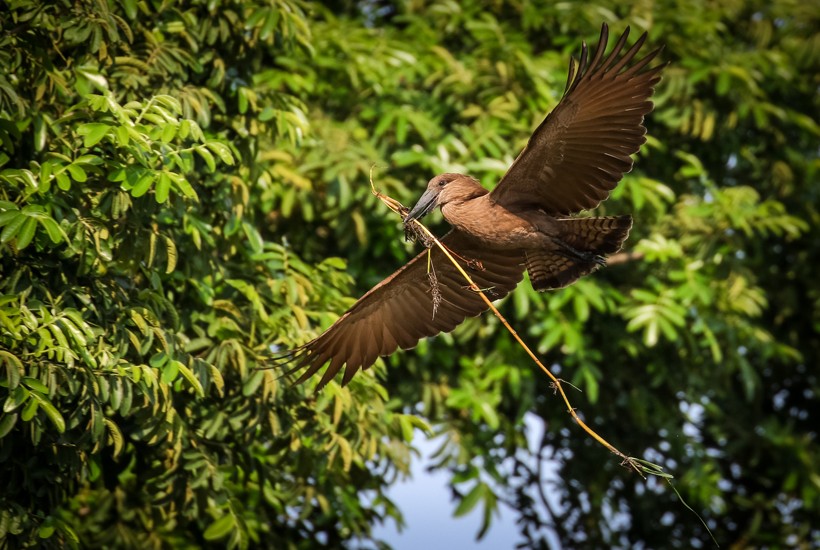
Hamerkop flying with a twig to build its nest, South Africa
?
Image credits: JMx Images/Shutterstock
The female Hamerkop normally lays 3 – 7 eggs that are white-colored in the beginning and become stained and soiled later on. Both sexes take turns for incubating the eggs which last for about 28 to 30 days. After the clutch hatches, both parents also take an equal part in feeding the young. At the time of hatching, the chicks are covered with a gray down and develop the adult coloration only after a month. However, the plumage over the head and crest can be seen developing just after 17 days. The chicks are tended for about 50 days after which they leave their parents’ nest and return to roost only during the nights for another 10 or 15 days. This marks their complete independence and maturity.
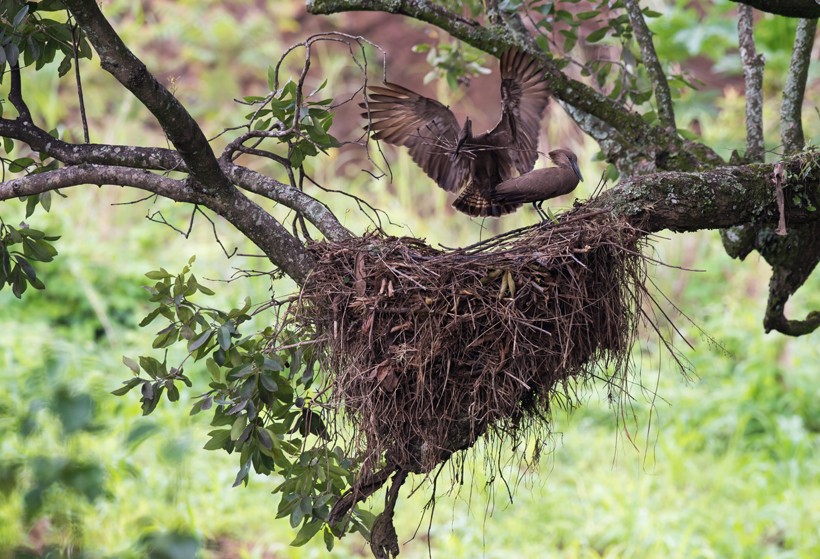
Hamerkops huge nest
?
Image credits: Dave Montreuil/Shutterstock
Unlike other wading birds, the Hamerkops often leave their young alone for longer periods during the day. This unusual habit might have evolved due to their ability of building large and thick nest walls which cannot be broken easily by predators.
Behavior, Communication & Intelligence
One of the strangest behaviors prevalent among the Hamerkops is their tendency to build huge nests that can be as wide as 1.5 meters (4.1 ft) across and consist of around 10,000 sticks. Some of these nests are even strong and big enough to support a man’s weight. The outside is generally adorned with different bright-colored objects that these birds collect from around their home range. To build their nest, they prefer trees located over rivers, ponds or lakes. However, a large number of nests of Hamerkops can also be spotted on river banks, cliffs, man-made walls, dams and even on the ground.
These birds normally build their nest in pairs. They begin by gathering sticks and mud to create a platform that serves as the foundation. Mud is used as an adhesive to hold together the large number of sticks. Upon the platform, they build an encircling wall which is then topped with a domed roof. The entrances of these domed nests are small openings (13 – 18 cm wide) placed at the bottom which opens into a tunnel with a length of around 60 cm (24 inches) and finally into the nesting chamber. They build the chamber within the widest part of the nest in order to make enough room for both parents as well as the young during breeding.
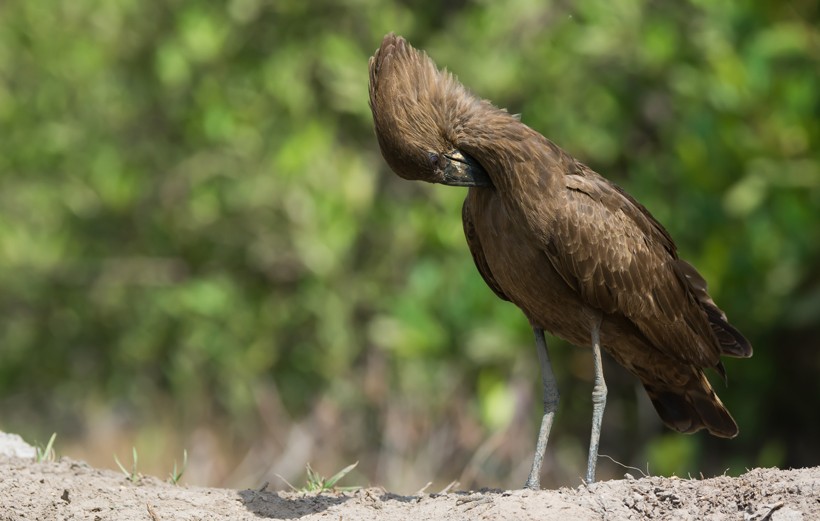
Hamerkop preening his neck
?
Image credits: Dave Montreuil/Shutterstock
Hamerkops don't depend on a breeding cycle for building a nest. They are considered as compulsive nest builders because they tend to build 3 to 5 nests every year even when they are not breeding. As the nests of these birds are thick and huge, large birds like Eagle Owls and Barn Owls often take over their nests by forcing out the owners. However, after the intruders leave the nest the Hamerkops reclaim and reuse it. Moreover, abandoned nests of these wading birds are often used by Snakes and small mammals such as Genets for shelter. Birds like Pigeons, Weaver Birds and Starlings often attach their own nest to the abandoned Hamerkops’ nest for better support and endurance.
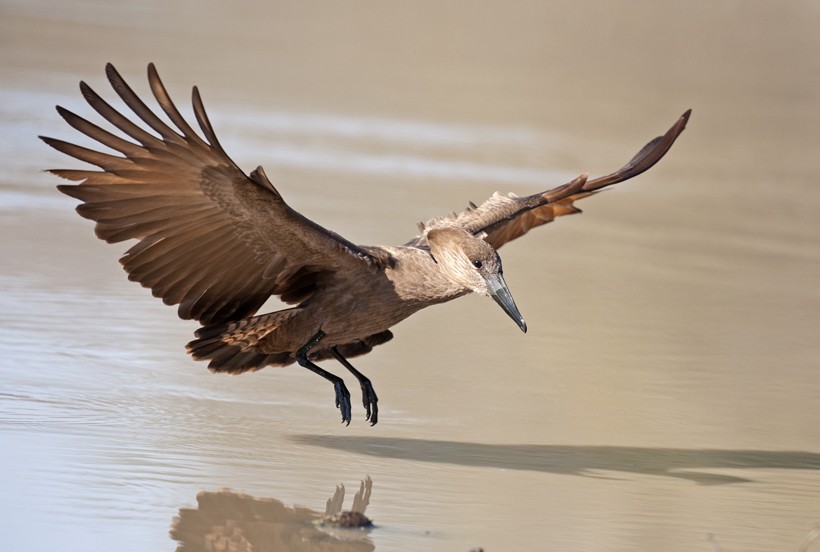
Hamerkop landing on the water, Kruger National Park, South Africa
?
Image credits: John Carnemolla/Shutterstock
Among all the wading birds found around the world, the Hamerkops have the most unique characteristics and display the most unusual behavior. One such unusual behavior involves the ceremonial gathering of around ten birds and running in circles altogether while calling out loudly and fluttering the wings and raising the crests. Besides this, Hamerkops also perform false mounting in which these birds stand on top of each other even when they are not mates. During this behavior, they pretend to mount each other but do not copulate. These birds become quite vocal when found in groups. In addition to this, Hamerkops have been seen frequently spying the ground by perching comfortably on the giant backs of Hippopotamuses.
Population and Conservation
The species of Hamerkop is abundant around their habitat as these birds can adapt well to any kind of aquatic environment within a short time. They are also not persecuted or hunted by people living close to their habitat owing to a number of traditional folklores depicting these birds in having magical powers. Moreover, the increasing number of artificial water body constructions, in order to cater to the needs of the expansion of human settlements, has benefited these birds to a great extent by allowing their prey to prosper. Therefore, the species of Hamerkop has been listed in the category of Least Concern on the IUCN Red List.
Presently, there are no major threats to the population of Hamerkop but gradual deterioration in the water quality of wetlands due to the excessive and continuous use of pesticides may affect these birds in future. Besides this, the large-scale trampling of floodplains by livestock also makes it difficult for these wading birds to find their amphibious prey. However, due to the stable population of Hamerkops in Africa, no specific conservation efforts or plans have been put into effect for the betterment of these wading birds.
Cultural Depictions
Since ancient times, Hamerkops have been associated with many legends due to its many unusual characteristics. Referring to the Hamerkops’ compulsive nature to build several huge nests per year, many indigenous people of Africa believe that other birds often help these Hammerheads to construct their enormous nests.
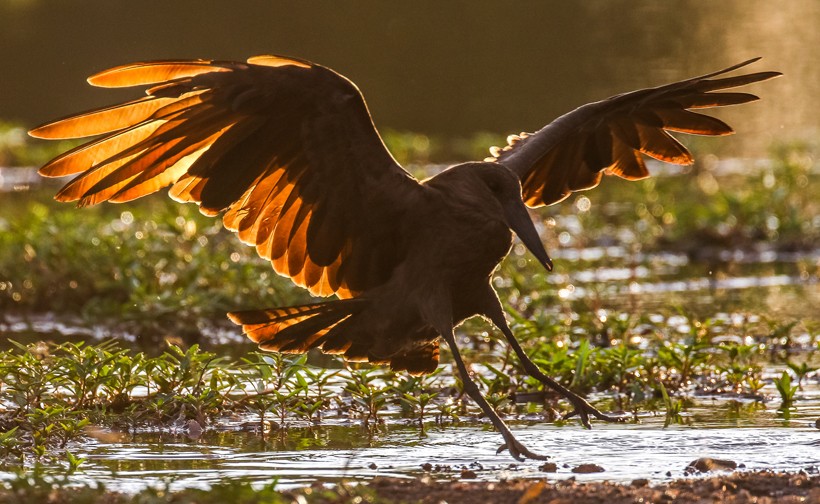
Hamerkop flying to river with light shining through wings
?
Image credits: JMx Images/Shutterstock
Beliefs about Hamerkops having magical power are still prevalent among many communities in Africa. In the language of Ixam, an extinct language of South Africa, Hamerkops have been mentioned as the messenger of death. It was believed that if a Hamerkop calls and flies over the camp, it meant that some close relative had died. Among the Kalahari Bushmen, this bird is also known as a lightning bird as they believe that if someone attempts to rob the nest of a Hamerkop, he or she will get hit by lightning. Another ancient Malagasy belief says that anyone who destroys a Hamerkop’s nest suffers from leprosy later on. One of the Malagasy poems even calls this bird as an “evil bird”.
Evolutionary History
It is very tricky to identify the exact species of birds having the nearest affinities with Hamerkops, which has made the task of tracing back the origins of this bird extremely obscure. As these birds display similar characteristics with a number of species of both the order Ciconiiformes and Pelecaniformes, its classification regarding the order is still debated and many zoologists consider Hamerkop still as a species of the order Ciconiiformes.
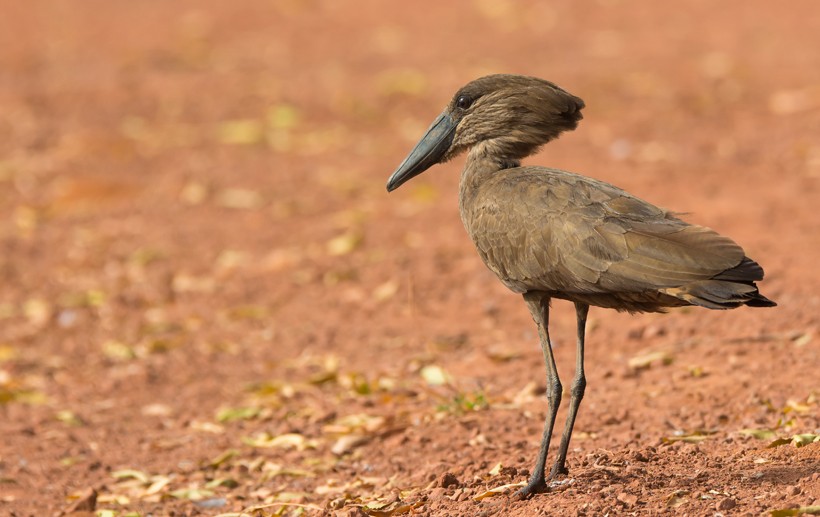
Hamerkop standing on a clay road
?
Image credits: Dave Montreuil/Shutterstock
Superficially, the bill of Hamerkops resembles the bill of both the Boat-billed Heron (cochlearius cochlearius) and Shoebill (Balaeniceps rex) but this similarity can be the result of convergent evolution. The pectinate middle toe exhibits similarities with the Herons but the free hind toe is seen mostly among the Flamingos. Besides this, the behavior and habits of Hamerkops are so unique that it has compelled the taxonomists to place this bird in its own family and genus.
Funfacts
- The species of Hamerkop is so peculiar that it has its own taxonomic family and genus of Scopidae and Scopus respectively.
- Hamerkops have partially webbed feet with a comb-like middle toe which they use to groom their feathers.
- Due to convergent evolution, Hamerkops have several similarities as well as differences with a number of wading birds of different families.
- The round-tipped and wide wings help the Hamerkops in soaring.
- Hamerkops are endowed with superior navigation skills which allow this bird to forage in farfetched areas without getting lost.
- Hamerkops engage in a typical behavior of false mounting in which they just pretend to copulate.
- Hamerkops are building large nests which are big and strong enough to support a man’s weight.
- The Hamerkop has a compulsive tendency to construct several huge nests without depending on their breeding pattern.
- The hamerkop is one of the most mysterious birds of Africa that has long been associated with several legends and folklores.
